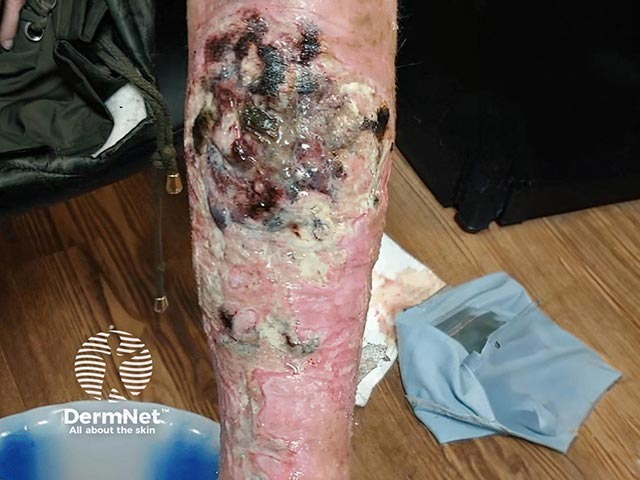Main menu
Common skin conditions

NEWS
Join DermNet PRO
Read more
Quick links
Last Reviewed: May, 2025
Author(s): Dr Aditi Sinha, IMT1 Doctor, Royal Brompton Hospital, London, United Kingdom; Dr Zsófia Sára Hermann, Paediatric Registrar, Tauranga Hospital, New Zealand (2025)
Reviewing dermatologist: Dr Ian Coulson
Edited by the DermNet content creation department
Introduction
Demographics
Causes
Clinical features
Complications
Diagnosis
Differential diagnoses
Treatment
Prevention
Outcome
Xylazine-induced skin ulcers often appear on the extremities as a result of injecting xylazine, a veterinary anesthetic that is increasingly used alongside or as an alternative to narcotic recreational drugs.
As a potent alpha-2 adrenoreceptor agonist, xylazine has been identified as a street drug known as "Tranq," frequently mixed with other substances, particularly fentanyl, to enhance their euphoric effects. Injection of xylazine carries a significant risk of ulcer development and abscess formation.
Xylazine-induced skin ulcers are commonly found in individuals who use injectable drugs, primarily through intradermal administration but also intravenously.
Cases have been reported mainly in the United Kingdom and the United States of America, particularly in Philadelphia and New York. Their prevalence is increasing due to the successful seizure of large quantities of opioids by the Drug Enforcement Agency, leading to xylazine use as an alternative.
Xylazine-induced skin ulcers result from the drug’s potent alpha-2 adrenoreceptor agonist effects, which cause profound vasoconstriction of skin vessels. This restricts blood flow to surrounding soft tissue, causing ischaemic necrosis.
Ulcers can develop at the site of infection but also in distant areas, increasing the risk for soft tissue infections, impaired healing, and recurrent infection.
Xylazine-induced skin ulcers primarily develop on the extremities, particularly over extensor surfaces. Skin changes typically include:
In addition to these skin changes, xylazine may cause systemic effects such as bradycardia, hypotension, and arrhythmias. There is also a risk of respiratory depression that may not respond to naloxone.

Necrotic leg ulcer due to injection of xylazine. From Malayala et al, Cureus
Xylazine-induced skin ulcers may be difficult to diagnose. Xylazine has a short half-life of 25-30 minutes, making detection in blood and urine toxicology difficult. Diagnosis is therefore primarily clinical, using a thorough history and examination.
Initial evaluation should include blood and wound cultures, while ultrasound and MRI imaging may be necessary to rule out complications such as osteomyelitis and necrotising fasciitis.
Xylazine-induced skin ulcers can be prevented by:
Xylazine-induced skin ulcers can result in a range of outcomes, from successful healing with appropriate treatment to severe complications such as chronic wounds, infections (including osteomyelitis), and potential limb amputation. Early intervention, such as with intravenous antibiotics and surgical debridement, is crucial to improve outcomes and prevent long-term disability.